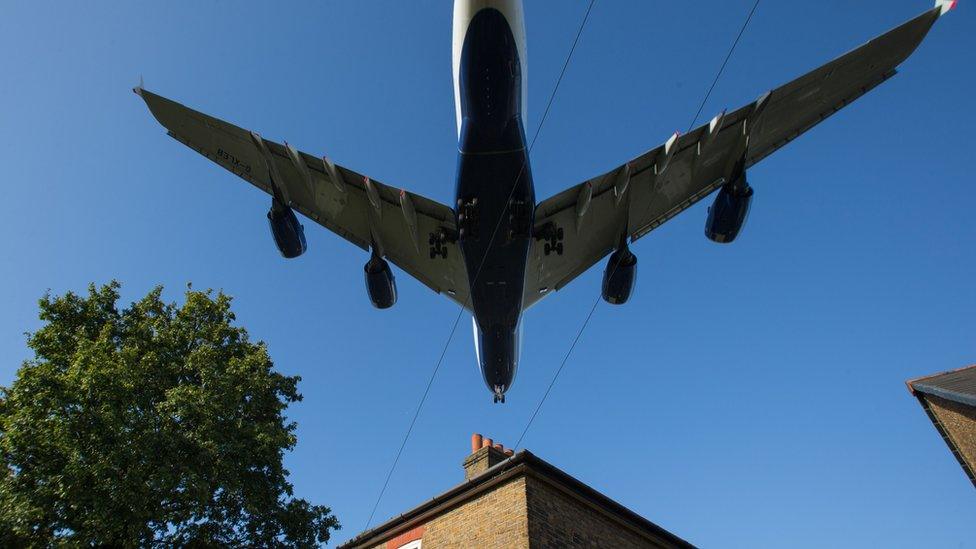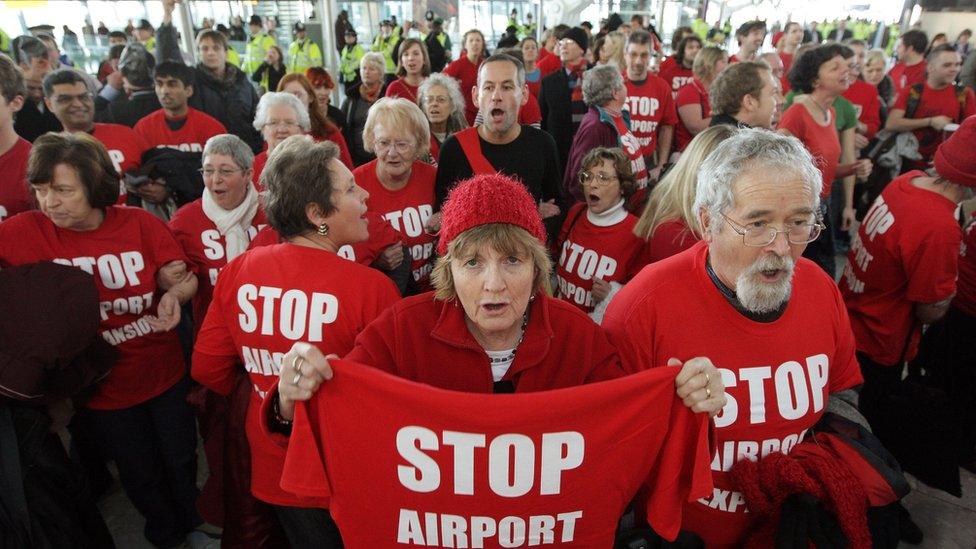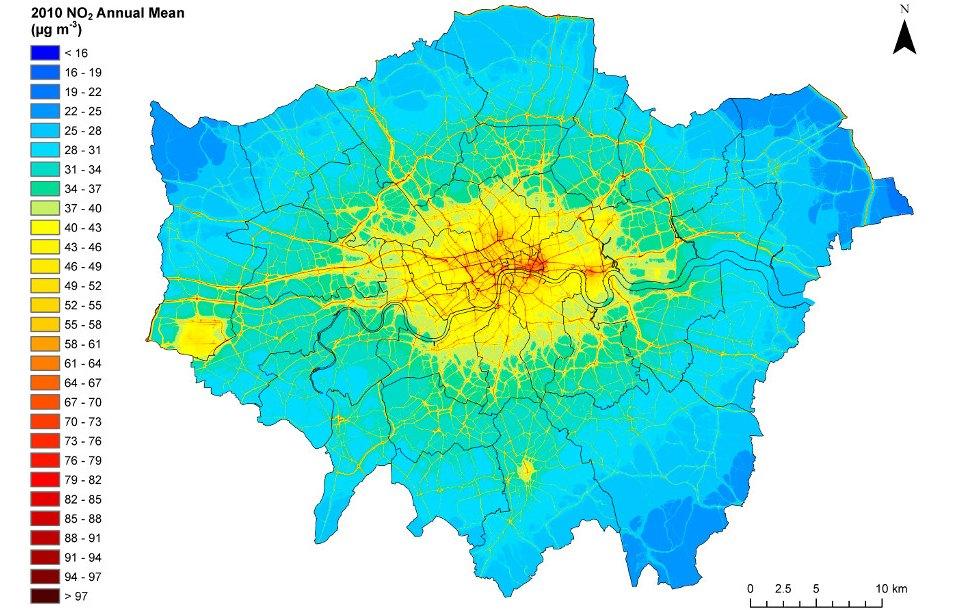The environmental costs of Heathrow expansion
- Published

There are environmental concerns about noise, air pollution and climate change
Significant questions about the environmental impacts of Heathrow's new runway remain unanswered in the wake of the government's announcement.
Opponents say that the expansion will make air quality and noise pollution much worse.
It makes a complete mockery of the government's commitments on cutting carbon emissions, they say.
But supporters of the airport say that developments in technology will mitigate many negative consequences.
Third runway at Heathrow cleared for takeoff
Why expansion is taking so long
Is new runway more important post-Brexit?
The green price of Heathrow expansion
Death sentence for Heathrow villages
In its final report on Heathrow last year, external, the Airports Commission was clear that an extra runway at the UK's biggest flight centre would be an opportunity to right some of the environmental wrongs that have developed through ad hoc expansion over the years.
These include increased levels of noise for local residents, consistent breaches of air pollution safety levels and increasing amounts of carbon dioxide (CO2) emissions.
Perhaps the easiest of these issues to tackle is noise.
The Airports Commission suggested that a "noise envelope" should be agreed and Heathrow would be legally bound to stay within these limits.
There should also be an increased noise levy to benefit local communities - and an independent aviation noise committee should be established with a statutory right to be consulted on operating procedures.

Campaigners say they will attempt to mount legal challenges against the expansion
In their statement announcing the airport's expansion, external, the government gave some clear indications of how it will tackle this question.
It will propose a six-and-a-half hour ban on scheduled night flights for the first time. It will also propose new legally binding noise targets that will encourage the use of quieter planes - and there will be a pot of cash, some £700m, to pay for noise insulation for local residents.
On the other two key environmental impacts the government is on far trickier ground.
When it comes to dirty air, the UK has been breaching EU limits for nitrogen dioxide (NO2) since 2010 in a number of different regions and cities. This pollutant is produced from diesel engines and is linked to a range of respiratory illnesses.
Heathrow has long been a hot spot for this type of air pollution due to heavy traffic in the vicinity - so much so that the Department for Food, Environment and Rural Affairs (Defra) projected that even without expansion, the A4 running north of the airport would still exceed EU safety limits for nitrogen dioxide in 2030, external.
The airport points to recent independent research, external that says the expansion would only lead to a "marginal" increase in NO2 from Heathrow as there would be significant reductions elsewhere thanks to changes in diesel engines and greater use of electric vehicles.
Campaigners are not impressed with this conclusion.
"The measures that people have put forward seem fairly far fetched in terms of implementation," said Tim Johnson, from the Aviation Environment Federation, external.
"Ideas like taking diesel cars off the road are indeed potential solutions, but how do you get consumer change that makes that happen in the time scale?"
Perhaps the biggest environmental challenge of the expansion is the impact on climate change goals.
Existing UK legislation commits the government to cut CO2 levels by 80% of 1990 levels in 2050.

In 2010 this image shows both central London and the area around Heathrow exceeding EU safe levels for nitrogen dioxide
Aviation right now accounts for around 6% of UK emissions. To meet the legal target, emissions from this sector would would have to stay below the 2005 mark.
This could be partly achieved with improvements in fuel and aircraft operational efficiency and the wider use of biofuels, says the independent Committee on Climate Change, external (CCC).
They are calling on the government to publish a strategic policy framework for UK aviation emissions to limit them to 2005 levels.
To keep below the target, the CCC says that "this could imply limiting the growth in demand to around 60% above 2005 levels by 2050 (45% above current levels)."
That could mean the government having to cut airport capacity in regional airports or have other sectors of the economy make deeper emissions cuts.
"You only have so much carbon to go round," said Tim Johnson.
"The government will have to decide how best to distribute that, if they decide to use that for a new runway then there will have to be a hit elsewhere."
But speaking in the House of Commons, Transport Secretary Chris Grayling refuted the suggestion that the expansion of Heathrow was bad for the climate.
"We take the issue of climate change very seriously and this government has a whole raft of measures in place to address the issue, but we also have to make sure that we have the prosperity in this country to do things like funding our NHS and funding our old age pensions, and having a thriving modern economy with strong links around the world is an important part of that."
Other campaigning groups believe the lack of a clear plan on how to mitigate increases in CO2 make the third runway a very bad idea.
"With the government poised to sign the Paris climate agreement, it's decision to expand Heathrow - shortly after forcing fracking on the people of Lancashire - looks deeply cynical," said Andrew Pendleton, from Friends of the Earth.
"However this is only the first step on a long journey that will see communities, councils and climate campaigners continue the battle to reverse this misjudged and damaging decision."
One area in which there is a little dispute over the benefits of Heathrow's expansion is in regard to wildlife. The airport has committed to a £105m plan to transform a green area, external near the airport, into a haven four times the size of Hyde Park.
Follow Matt on Twitter @mattmcgrathBBC, external and on Facebook, external.